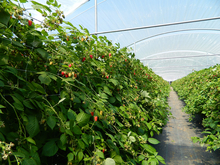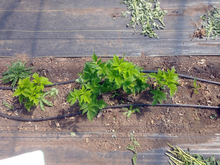The most obvious advantage of growing raspberries in high tunnels in Minnesota is the extended harvest season. But growers are also drawn to its other benefits like increased fruit quality, higher yields, reduced disease incidence due to exclusion of rainfall, and protection from wind, hail, and birds. This is why high tunnel raspberries are a popular system in major berry producing regions like California, Quebec and parts of Europe.
As climate change brings wetter seasons and more intense rain events, high tunnels protect high value crops from the elements.
For farmers who are deciding what crop to use existing high tunnel space for, consider raspberries. They are a high value, high demand crop that produces strong yields in high tunnels.
As with any high tunnel crop, be sure to water regularly and provide ventilation to moderate the temperature.
Many of the recommendations provided in other sections of this raspberry guide apply to both high tunnel and open-field production. This section of the guide outlines additional considerations that growers should make when growing in high tunnels specifically.
Choosing raspberry types for high tunnels
Studies conducted by several universities have found higher yields with primocane-fruiting varieties than floricane-fruiting varieties when grown in high tunnels.
The harvest season for primocane-bearing raspberries is extended in high tunnels; these varieties will continue producing fruit until they are terminated by a fall frost, which happens later in a high tunnel. Their harvest season generally starts about 2 to 3 weeks earlier than open-field fall-bearing raspberries.
Floricane-fruiting raspberries grown in a high tunnel typically ripen 2 to 3 weeks earlier than field plantings, or around mid- to late-June in Minnesota depending upon variety selection.
Varieties
Generally, the same varieties can be grown in high tunnels and in the open field. It is logical that some less hardy (Zone 5) varieties may be viable in Minnesota high tunnels as well, thanks to the extended high tunnel season. Research is currently ongoing to learn which varieties perform best in a typical Minnesota high tunnel, so it is premature to provide a list at this time. Refer to Raspberry types and varieties.
Challenges
Hot air- and soil-temperatures during the fruiting period can adversely affect floricane-fruiting yield in high tunnels. For example, research at Iowa State University found reduced ‘Tulameen’ yields and a shortened harvest season due to intense heating of the tunnel environment in June, July and August, whereas the primocane fruiting ‘Autumn Bliss’ saw no change in yield.
Ventilation is very important in high tunnels to prevent heat-related leaf injury.
Disease management
Disease incidence in high tunnel raspberries should be significantly lower than open-field raspberries due to the exclusion of rainfall.
For example, botrytis gray mold is less common in tunnels with drip irrigation, because the pathogen that causes it spreads with rainfall or overhead irrigation which do not occur in tunnels.
You can largely prevent disease in tunnels via good cultural management practices:
- Prevent physical cane injury by practicing care when hoeing and string trimming.
- Use clean tools and clothing to minimize transmission of infected soil.
- Keep the soil appropriately irrigated (not overly wet).
- Do not use overhead irrigation in high tunnels.
- Maintain ventilation in the tunnel to prevent excessively high humidity.
- Manage weeds on the outer perimeter of the tunnel, as some weeds can serve as hosts of certain raspberry diseases.
- To prevent phythophthora root and crown rot, be careful not to overwater and do not use mulch in the raspberry rows.
Refer to Raspberry diseases for more information.
Weed management
The need for proper weed management is heightened in high tunnel production.
While the enhanced microclimate of high tunnels benefits plant growth and development of many high-value crops such as raspberries, plant vigor is also advanced in weed species. Growers often have a more difficult time combating nutrient and pest management issues in high tunnel berry production without proper weed management strategies in place.
On the other hand, some high tunnel growers may observe fewer weeds than when growing in the field, because the drip irrigation targets water to the rows only, allowing little weed growth in the aisles.
In-row: As with open-field production, hand-weeding and herbicides are the primary weed management tools in the rows. Landscape fabric is not recommended in the rows, because it significantly limits cane growth and plant yield. Non-living plant-based mulches like wood chips increase the risk of saturated, cool soils and phytophthora infection.
Between rows: Growers can choose among a variety of weed management approaches for the walking aisles in high tunnels. These include landscape fabric, bare soil, and non-living plant based mulches (i.e. straw, wood chips). Do not use living cover crops between the rows in high tunnels - they provide a refuge for insect pests such as spider mites and require additional water.
The herbicide options for high tunnel raspberries are the same as those for open-field raspberries.
Please refer to Weed management in raspberries for more information.
Insect pest management
Spider mites are more common in high tunnel raspberries than in open-field production, because they thrive in drier environments. Japanese beetles may be slightly less common inside tunnels than outside. Aside from that, the insect pest management recommendations are similar to open-field raspberry production.
Trellising
Both primocane- and floricane-bearing raspberry should be trellised when grown in high tunnels. The canes grow faster and taller in tunnels than outside, so trellising is necessary to support them and keep them out of the walking aisles.
- Primocane-bearing: Use at least 2 trellis wires at about 3 and 6 ft heights. Install additional wires if necessary to contain the canes as they grow.
- Floricane-bearing: Additional wires located lower than 3 ft, and between 3 ft and 6 ft, are often needed as floricane-fruiting varieties tend to position fruiting-laterals lower on the cane.
For floricane-bearing varieties, separating fruiting canes from vegetative primocanes aids in harvest accessibility. Growers can achieve this by training all floricanes to the left side of the trellis and all primocanes trained to the right side. Modular trellising systems with adjustable arms such as “rotating cross arm trellises” offer a more sophisticated way of achieving the same result, while reducing labor. They also allow growers to minimize row widths when floricanes are not in production.
Nutrient management and irrigation
- High tunnel raspberries require irrigation.
- Use drip irrigation and fertigation for high tunnel raspberries.
- Do not attempt to water via overhead sprinklers - this negates the disease management benefit of high tunnels by encouraging foliar diseases that infect wet leaves.
- High tunnel raspberries have greater water needs than open field raspberries because they grow larger and produce more fruit, and because of the elevated temperature in high tunnels.
- A more permanent drip line system is generally more favorable than disposable ones as they tend to be less susceptible to rodent and insect damage.
The bullet points above just summarize high tunnel-specific considerations. For full information on raspberry irrigation and nutrient management, see Irrigation and nutrient management.
Preparing for winter
Most high tunnel growers around the country remove the plastic from the tunnels in the late fall and replace it in the spring. It is much less common to leave plastic on tunnels over the winter, though some berry farmers in Minnesota do this successfully.
- For floricane-bearing raspberries, uncovering the tunnel during the winter is safer than leaving the plastic on.
- Leaving tunnels covered is risky for summer-bearing raspberries. It causes temperature fluctuations that force the canes to break dormancy and lose their winter hardiness, ultimately leading to floricane dieback.
- Fluctuating winter temperatures in a covered tunnel present less of a risk for fall-bearing raspberries because they do not rely on overwintering canes for fruit production. It is okay if some cane dieback occurs.
- The other advantage of uncovering the tunnels is that it lets snow in. Snow cover prevents the roots and canes from desiccating, and helps flush out accumulated salts from irrigation water.
- If leaving the plastic on the tunnel over the winter, berry Extension experts in the Great Lakes region recommend thoroughly watering the soil right before turning off the irrigation in the late fall to help prevent root desiccation.
- It is unclear whether covering the base of the plants with mulch (i.e. straw or fabric) over the winter is beneficial.
- Water as soon as possible in the spring.
Reviewed in 2022





